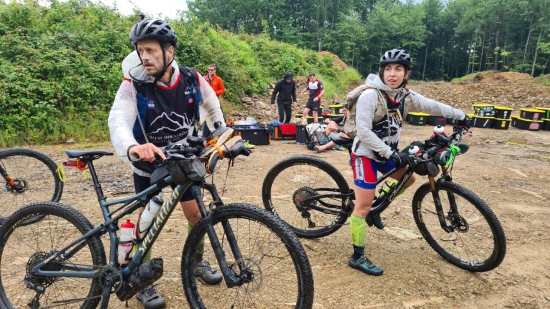Endless Mountains Adventure Race
Day Two at Endless Mountains - Race Directors' Review
Abby Perkiss & Brent Freedland (Rootstock Racing) / 22.06.2022


Day two of the 2022 Endless Mountains gave racers a taste of true Pennsylvania summer –storm claps, high heat, and as darkness fell, fireflies lighting up the woods.
Following a quiet and cool night, a storm system rolled across the region. Down at Curwensville Lake and Bilger’s Rocks, where much of the field was concentrated, teams encountered only light showers. But for lead teams Bones and Bend Racing, 45 minutes of persistent downpours were punctuated by sharp bursts of thunder and lightning.
They arrived at TA4 just as the skies cleared, but they were notably chilled, despite the final climb to the remote gravel quarry where their bikes and gear would spend the next day or more.
As she transitioned, Chelsey Magness of Team Bend remarked, “That was spicy! Is this common weather out this way?”
Welcome to the PA Wilds.
Bones arrived at TA seventeen minutes in the lead, but by the time they departed, their lead had shrunk to seven minutes. Rib Mountain Racing was next into TA, 85 minutes behind the leaders. They were eager to put their navigational chops to good use on what has been described as the crux of the race – a 50-mile/80-kilometer rogaine through the Quehanna Wild Area.
The Quehanna Wild Area is a time capsule of Pennsylvania’s past. “All over the Wilds, racers will find remnants of development, largely in the form of roads and stone walls,” said co-RD Brent Freedland. “There are so many traces of the past, but there’s not a whole lot left in a substantial way.”
True to most events that Freedland and Abby Perkiss have directed, racers here will be rewarded for strong navigation, smart route choice, and efficient off-trail travel. But unlike many Rootstock races in Pennsylvania, the land in this region is characterized less by sharp ridges and spurs and more by high plateau travel. The terrain isn’t flat, but it’s subtle by PA standards, and less rocky as well.
Still, travel will be slow. “The area is thickly vegetated,”Freedland continued, “and there are a lot of human-made features that won’t show up on the maps – old roads, tracks, overgrown fields. Opportunities to run are rare, even on the trails, which are typically gnarled.”
This landscape creates challenges for race personnel as well. Roads off of the Quehanna Highway – the main artery through the region, but “highway” is a bit of a misnomer – degrade quickly into surfaces where bike travel will be faster than car. It’s difficult for the media staff to access the course, so they are relying as much on the live tracking platform as spectators are in order to catch teams in the woods.
Top teams were particularly challenged by checkpoint 25. Race directors envisioned two potential points of attack here. The more direct route is the approach from below; here, teams will ascend a 700-800-foot climb straight up a ridge. Near the top, they will encounter a field of standalone boulders, and beyond that the land flattens into a classic Pennsylvania rock band. It is a navigable scramble, but teams may poke around a bit to find a suitable route. The checkpoint is at the top of that band.
From a navigational perspective, the CP is the most difficult mandatory point on the stage, likely on the whole course, and lead teams seemed particularly challenged by it. Bones spent several hours attacking and reattacking before they nabbed it. Rib Mountain Racing noted that they had to use every tool in their navigational arsenal to find it. A bit further back, Deviate and Recalculating may have benefited from darkness, where reflective tape would make the point easier to spot with a headlamp. Since then, close to a dozen teams have found it without issue, both in the darkness and since the sun came up on day three.
As of this writing, eleven teams remain on the full course. Behind them, the field is wide open, with many opportunities for strategic short-coursing still to come. Spectators may question racers’ decision to skip points, but Perkiss and Freedland applaud the teams. “This is a savvy field of racers, top to bottom,” said Perkiss. “Even those less experienced at expedition racing are projecting forward thoughtfully and making moves that will keep them heading toward the finish line within the time allowed.”
Perkiss and Freedland expect most of the field to remain on Stage E for the bulk of day three. The forecast calls for scattered strong storms through the afternoon. Teams may be challenged by the conditions, but they will no doubt appreciate the relief that will come when the storms abate and the temperatures begin to fall.
See All Event Posts





